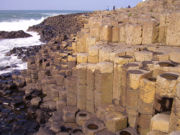Giant's Causeway
2007 Schools Wikipedia Selection. Related subjects: European Geography
The Giant's Causeway is an area of 40,000 interlocking basalt columns resulting from a volcanic eruption. It is located about 2 miles (3 km) north of the town of Bushmills in County Antrim, Northern Ireland along the northeast coast of Ireland. It was declared a World Heritage Site by UNESCO in 1986, and a National Nature Reserve in 1987 (by the Department of the Environment for Northern Ireland). In a 2005 poll of Radio Times readers, Giant's Causeway was named as the fourth greatest natural wonder in the United Kingdom. It's the centerpoint of many famous photos, notably the cover of the Led Zeppelin album Houses of the Holy. The Giant's Causeway is owned and managed by the National Trust. The tops of the columns form stepping stones that lead from the cliff foot and disappear under the sea. Most of the columns are hexagonal, however there are some with four, five, seven and eight sides. The tallest are about 12 metres (36 ft) high, and the solidified lava in the cliffs is 28 metres thick in places.
Legend
Legend has it that the Irish giant Fionn mac Cumhail (Finn McCool) built the causeway to walk to Scotland to fight his Scottish counterpart Benandonner. One version of the legend tells that Finn McCool fell asleep before he got to Scotland. When he didn't arrive, the much larger Benandonner crossed the bridge looking for him. To protect Fionn, his wife Oonagh laid a blanket over Fionn and pretended he was actually Fionn's baby son (in a variation, Fionn fled after seeing Benandonner's great bulk, and asked his wife to disguise him as the baby.) In both versions, when Benandonner saw the size of the 'infant', he assumed the alleged father, Fionn, must be gigantic indeed. Therefore, Benandonner fled home in terror, ripping up the Causeway in case he was followed by Fionn.
The Scottish side of the causeway on the isle of Staffa has similar basalt formations at the site of Fingal's Cave that are part of the same ancient lava flow.
History
During the Paleogene period (62-65 million years ago), Antrim was subject to intense volcanic activity, when highly fluid molten basalt intruded through chalk beds to form an extensive lava plateau. As the lava cooled rapidly, contraction occurred. While contraction in the vertical direction reduced the flow thickness (without fracturing), horizontal contraction could only be accommodated by cracking throughout the flow. The extensive fracture network produced the distinctive columns seen today.
The "discovery" of the Giant's Causeway was announced to the world in 1693 by the presentation of a paper to the Royal Society from Sir Richard Bulkeley, a fellow of Trinity College, Dublin, although the "discoverer" had, in fact, been the Bishop of Derry who had visited the site a year earlier. At the time there was much argument as to whether the Causeway had been created by men with picks and chisels, by nature, or by the efforts of a giant. The issue was not settled until 1771 when a Frenchman, Demarest, announced the origin of the causeway to be the result of volcanic action.
Similar structures
Although the basaltic columns of the Giant's Causeway are impressive, they are not unique. Basalt columns are a common volcanic feature, and they occur on many scales (faster cooling produces smaller columns). Other notable sites include Fingal's Cave in Scotland, the Garni gorge in Armenia, the Cyclopean Isles near Sicily, Devils Postpile National Monument in California, Devils Tower National Monument in Wyoming, Basalt Prisms in Hidalgo, Mexico, and the "Organ Pipes" formation on Mount Cargill in New Zealand.
Notable features, flora and fauna
Some of the structures in the area, having been prone to several million years of weathering, resemble objects, such as the Organ and Giant's Boot structures pictured here. Other features include many reddish, weathered low columns known as Giants Eyes, created by the displacement of basalt boulders; the Shepherd's Steps; the Honeycomb; the Giant's Harp; the Chimney Stacks; Fingal in Northern NSW (Australia); the Giant's Gate and the Camel's Hump. The area is a haven for sea birds such as fulmar, petrel, cormorant, shag, redshank guillemot and razorbill, while the weathered rock formations host a number of rare and usual plants including sea spleenwort, hare's foot trefoil, vernal squill, sea fescue and frog orchid.







